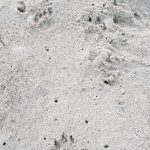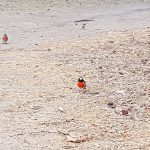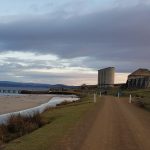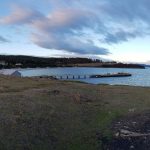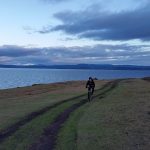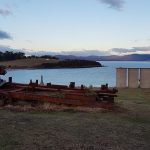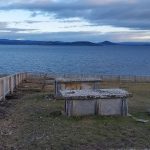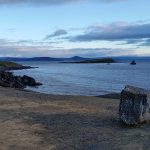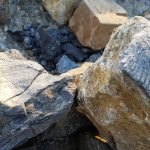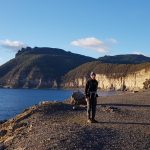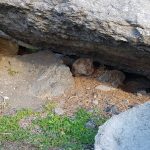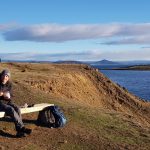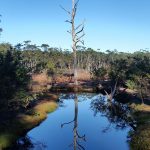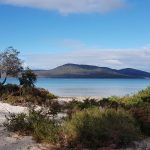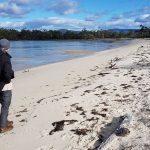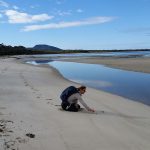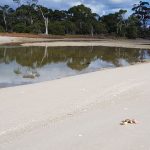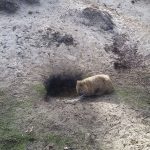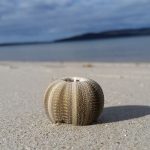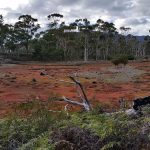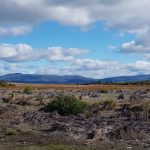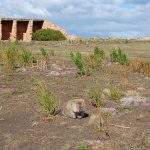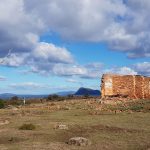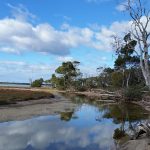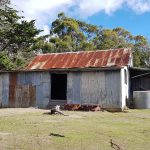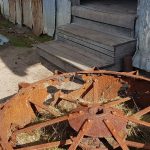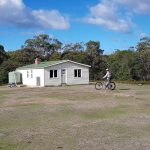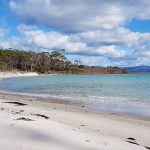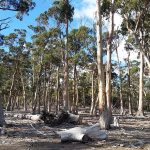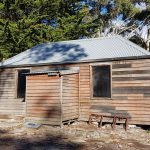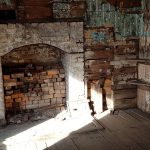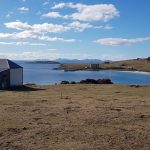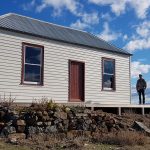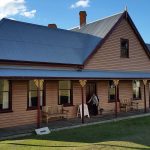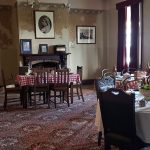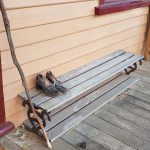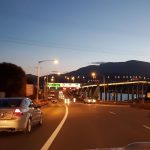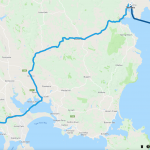Sunday 12th May, 2019
Today dawned with sunshine. It was a beautiful start to Mother’s Day 2019. We started the day with a chat to both our mothers which was lovely, the day followed with calls from all three children which was also lovely to speak with them. We rode to Fossil Cliffs offering an insight into the past environments of Maria Island. Extending along the northern shores of the island, these spectacular cliffs plunge sheer to the sea with expansive views of Freycinet Peninsula and Schouten Island. A former limestone quarry allows you a close look at the many animals immortalised as fossils in the rocks. We also rode past the wharf, the silos, the Miller’s House, the Cemetery, the convict barn and the Commissariat Store.
We had breakfast overlooking the ocean to Freycinet Peninsula. We then continued our bike to the southern part of the island to the Isthmas we had seen from Mt Maria yesterday. The ride was mainly along a dirt, gravel road, after the activities of the last 2 days a nice flat ride was warranted but unfortunately it was undulating and sometimes quite decent hill climbs. Those calves, glutes and quads were burning yet again. We rode past the Painted Cliffs, Coxswain Creek, Four Mile Creek and some beautiful beaches. We had morning tea at the beach that continues to the Isthmas, we had a lovely walk following some Tassie Devil tracks again. We then headed back and David went to Encampment Cove and I headed to the Convict Cells at Point Lesueur and we met up there, the first and largest ruins met are those of the Separate Apartments located to the west. Used as a probation station in 1845 these red brick ruins once housed up to 336 men. Now only a few cells remain intact. From here the trail goes to the barn and mill ruin. We then rode through the wetlands on our return journey. We stopped at a few buildings on the way back, Frenchs Farm, Howell’s Cottage and Mrs Hunt’s Cottage. As the day progressed I improved my dirt trail riding even getting a little faster. Thank goodness I think DB was saying. It was a lovely scenic ride albeit a little long (40km) and a bit too hilly for our tired legs.
We arrived back at camp at about 1.45pm in time to pack up camp. Looks like we will only have a quick trip around the main buildings at Darlington as we are running out of time as usual. Always trying to fit too much in to any day. At least we have reached the furthest parts and climbed the highest peaks so when we come back at a later stage we can explore the history of the island a bit more.
We have seen so much wildlife here, 100’s of wombats, pademelons, grey kangaroos, turbo chooks, Cape Baron geese, scarlet robins, wedge tailed eagles, but no Tassie Devils. Oh well maybe next time.
We have headed to Sandy Bay, just south of Hobart for a day of rest tomorrow. Finished off the night with a beautiful Italian meal at Solo Sandy Bay, thanks Gavin, Kristy, Frankie and Arlo.
Still no pictures tonight as we are headed out for a Mother’s Day dinner. I will work on the photos tomorrow and let you know when they are there to view. Sorry but we have taken over 600 photos in the last 3 days and that takes a while to go through and name.
A little bit of Maria Island history
The original inhabitants of Maria Island were the Puthikwilayti people – aboriginal people, and members of the Oyster Bay tribe. For more than 40,000 years the Puthikwilayti people were custodians of the land and surrounding waters.
European explorers first caught sight of the island in 1642, but didn’t come ashore until 1789. John Henry Cox and Lieutenant George Mortimer (English explorers) were the first Europeans to step foot on the island and document the presence of Aborigines.
In 1825, fifty convicts were brought to the island by English soldiers. The settlement of Darlington held convicts who had reoffended and they were sentenced to hard labour.
Due mainly to frequent escape attempts, the settlement closed in 1832, only to re-open again some 10 years later. The second convict era lasted for eight years (1842 – 1850) with a focus on agriculture, industry and training. Once again convict rebellion was a factor that led to its closure.
The Darlington Probation Station is today, the most intact example of a convict probation station in Australia, and one of eleven convict sites recognised by UNESCO as a World Heritage Site.
In the 1880s Diego Bernacchi, an Italian businessman, leased the land with ambitious plans for agriculture, industry, and tourism (wine and concrete!). At it’s peak the island had a population of 500, many buildings were re-purposed and others were built. The concrete silos adjacent to the jetty remain as a prominent visual reminder of his entrepreneurial spirit.
Farming and fishing ventures followed the Italian’s failed business pursuits, and eventually the island was declared a National Park in 1972.
- Just a few more devil tracks to torment David.
- Scarlet robin at our campground
- Darlington Bay
- Cement silos at Darlington Bay
- Early start on the Fossil Cliff circuit before breakfast. As we were going to the base of the north part of the island today.
- Convict barn built in 1844. This large building was erected in 1844 as a store for agricultural produce from the nearby farm, about the site of the present airstrip. There are two features unusual in a convict building: it was not white-washed internally, and it boasts a triple diamond pattern high on the external wall facing the Cemetery. During the 1920s it became a machine repair and carpenter’s shop for the cement company’s railway system.
- Looking out towards the cemetery. The cemetery During the convict days this cemetery was for free settlers. Convicts and many others lie in unmarked graves somewhere on the island. These graves date from 1825 to 1942, reflecting the various periods of island history.
- The people buried in this cemetery have been linked with the island in various ways over many years, they include: James Jarvis, a child of six months, buried in May 1825. He was possibly the son of one of the early officers. The inscription to Margaret Boyd tells its own story. Her husband (James Boyd) was to become the head of a number of convict stations, including 18 years in charge of Port Arthur. Hohepa te Umuroa was one of the lesser Maori chiefs imprisoned on the island for ‘rebellion’. Aged about 25 years, he was over 185 cm tall and died of tuberculosis on 19 July 1847. The Superintendent’s one year old son, Charles Lapham, was buried here in June 1848 and the Visiting Magistrate, Capt Benjamin Bayly, was interred after his death on 3 March 1850. Thomas Adkins was works manager of the first cement works and died in June 1890 while preparing a sample of cement for the Melbourne Centennial Exhibition. His wife Rosa (who was later to run the island’s Boarding House) died in 1942 at the age of 94 years and was the last person to be buried in the Maria Island cemetery.
- Fossil Cliffs
- Here you can see a variety of fossils including sea fans, coral-like creatures, scallop shells and sea lilies. It is thought that such an extensive accumulation of fossils may be related to the cold conditions associated with the polar sea of the time. Amongst the fossils are some large rocks, called dropstones. These were transported by floating ice, which melted, dropping the stones onto the sea floor to settle amongst the finer sediments…
- ..The stones consist of different rock types, including granite and quartzite, and may have come from nearby, or from great distances away…
- Fossil area with Bishop and Clerk in the background
- Hidey hole for a wombat down with the fossils
- Breakfast and morning calls to our mothers for Mother’s Day. What a view.
- Heading down south – Four Mile Creek
- Encampment Cove
- More devil tracks to follow on Encampment cove
- Some lovely shells on this beach
- They were very pretty
- A wombat came down on to the beach for a drink
- An unusual shell found on the beach
- Encampment Cove
- Heading to Pt Lesueur, see the grey kangaroos standing like statues hoping I don’t see them
- Convict cells at Pt Lesueur with resident wombat in the foreground.
- Convict cells
- Creek at Encampment Cove
- Woolshed at Frenchs Farm
- Remains of machinery outside the woolshed
- The restored French’s Farm modest homestead set in a clearing towards the South of Maria Island and was built during the 1950’s when farming was introduced to the island.
- Four Mile Beach
- Forest along the way near Howell’s Cottage
- Howells cottage. The Howells were a farming family who came to Maria Island early in the 1900s and were among the last permanent residents to leave Maria Island before it became a National Park in 1972..
- ..if you look closely the inside is lined with wood from old packing cases and then covered with newspapers.
- During the first convict period the Commandant, Major T. D. Lord, constructed his own residence on this hill. Then Mrs Hunt’s house was built in the early 1900s, over the ruins of the old Visiting Magistrate’s dwelling of the second convict period. As you can see, the position commands an excellent view of Darlington and the surrounding waterways, which would have been important for the commandant and later for Mrs Hunt…
- Ruby Hunt was by all accounts a bit of a character and operated a pedal wireless, which at the time was the only communication link with the mainland of Tasmania. It is also said that she would hang a lantern in her cottage window to guide in the ship that collected and delivered the mail for the island.
- Very apt photo for mother’s day. mother and child feeding in the pastures
- Coffee Palace 1888 Erected by the Maria Island Company, it was at times described as a restaurant before its official opening on 3 October 1888. It had two dining rooms and lounge room at the front with seven small rooms and kitchen at the rear. It became Adkins Boarding House in the early 1900s…
- ..The Coffee Palace underwent significant conservation works in 1998 and now houses a museum. The museum comprises two front rooms — the Reading Room and the Dining Room. Both are furnished as they would have appeared during the 1920s.
- Shoes need to be removed to go inside. I had ten minutes to make the ferry, so only a quick look inside.
- Heading over the Tasman Bridge with Mt Wellington in the background.
- Our little haven for the next 2 nights.
- Our bike ride was about 40km today, followed by the ferry ride and then 107km drive back to Sandy Bay Hobart. A little exhausted now.
